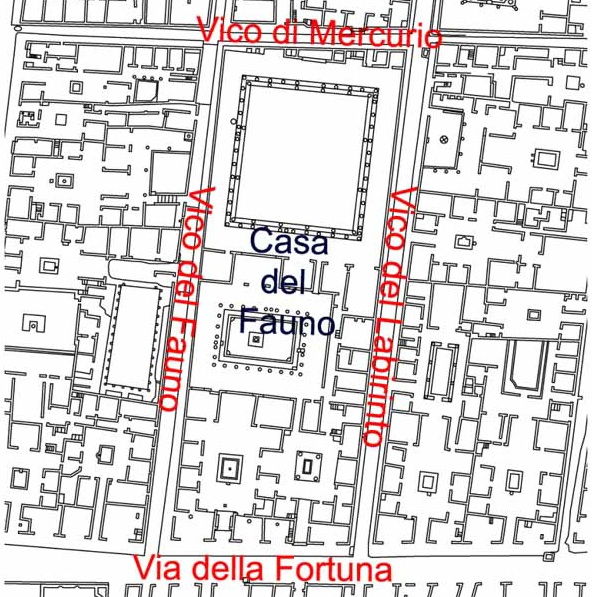

The House of the Faun was built in the second century BC during the Samnite period (200-80 BC). It was repaired after an earthquake in AD 62 and survived until the eruption of Mount Vesuvius in AD 79.
The house took up one city block, or insula, and formed the shape of a parallelogram because the surrounding streets were not laid out in an exact grid pattern. The internal rooms were rectangles with the exception of the irregularly shaped end rooms due to the parallelogram perimeter. The perimeter of the inscribed rectangle formed a 4:10 rectangle, made up of two smaller 4:5 rectangles placed end to end.

The ownership of the house is not known, but several artifacts and inscriptions found during excavations have lead to hypotheses about possible owners.
The Cassius family:
A body of a woman was found in the house who was killed by the eruption of Vesuvius. She was found wearing a ring with the engraving Cassius along with other expensive jewelry. Graffiti reading M. Cassius was also found in the house on a Doric column. These clues lead one to believe that the house belonged to the Cassius family. But a problem arises because references to the Cassius family in Pompeii come only from the Roman Imperial period, after the eruption of Mount Vesuvius. The ring could therefore mean the woman was of the Cassius family and married into the family who owned the House of the Faun. This leads to the conclusion that the Cassius family was related to the owners of the house through marriage, before the eruption of Vesuvius.
The Satrius Family:
An inscription on a slab of travertine was also found in the house. Some believe the slab came from the base of an ancestral statue while others take the view that the inscription came from a public monument. The exact purpose of the inscription is unclear, but the presence of it in the house leads to the conclusion that the Satrii were the original owners of the House of the Faun.
Though the owners of the house are unknown, the extravagant mosaics and decorations found in the House of the Faun have proved that the inhabitants were of the aristocratic class.